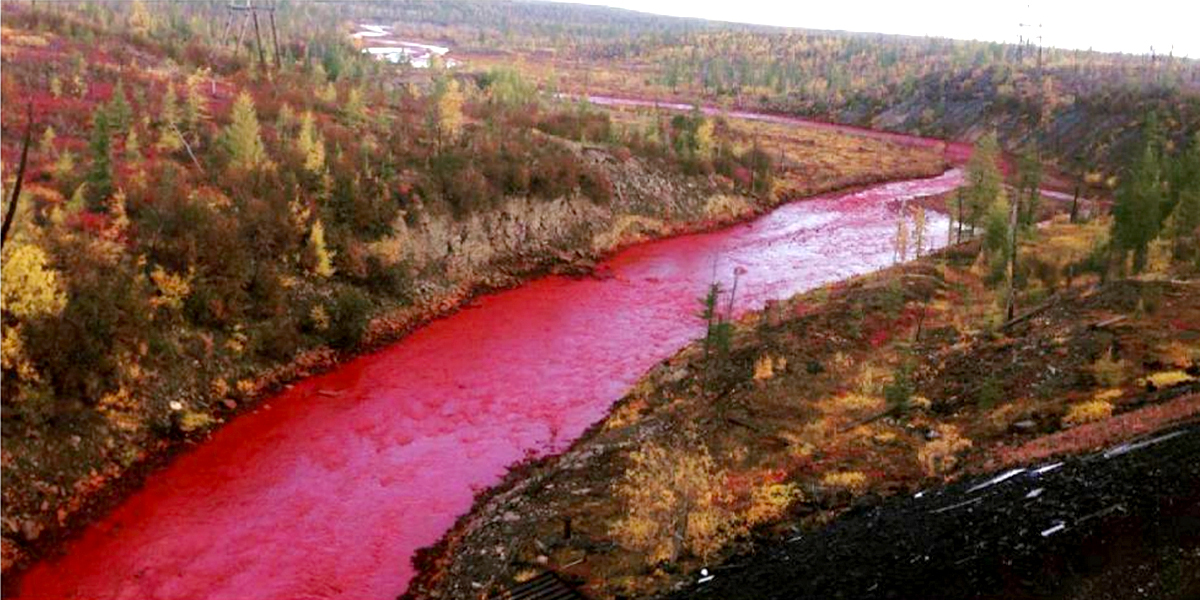

The Daldykan river near the industrial city of Norilsk in Russia turned an unnatural bright red on Tuesday, with some locals pointing fingers at industrial waste stemming from a nearby nickel plant.
#Norilsk, northern #Russia: the site of copper & nickel #mining & #environment|al degradation pic.twitter.com/2s6kRXPsql
— Alex Kokcharov (@AlexKokcharov) September 7, 2016
Russian authorities are
investigating the situation and are assessing any possible environmental damage. Russia’s Ministry of Natural Resources and Environment said Wednesday that a broken pipeline leaking “an unidentified chemical” from the Nadezhda Metallurgical Plant owned by Norilsk Nickel might be the culprit, CNN reported.
Norilsk Nickel is the world’s largest producer of nickel and palladium. The company has denied any wrongdoing, as the Guardian reported from state news agency RIA Novosti.
The “color of the river today doesn’t differ from its usual condition,” the company said, but added that production has been temporarily reduced as the situation is being monitored.

The Siberian Times reported that Norilsk Nickel has since provided photos of the river with a normal color to local news agency Tayga Info. However, as the Siberian Times noted, there is reason to suspect that the company did not provide a photo of the same stretch of river.
“As far as we know, the color of the river is today no different from normal,” a company source said.
Norilsk, located in the Arctic Circle, is the world’s northernmost city and is covered with snow for up to 270 days of the year. The city not only has an odious history as a Siberian slave labor camp, it’s one of the world’s most polluted places, as TIME magazine described:
“Home to the world’s largest heavy metal smelting complex, more than 4 million tons of cadmium, copper, lead, nickel, arsenic, selenium and zinc are released into the air every year. Air samples exceed the maximum allowance for both copper and nickel, and mortality from respiratory diseases is much higher than in Russia as a whole.”
“Within 30 miles (48 km) of the nickel smelter there’s not a single living tree,” Blacksmith Institute president Richard Fuller told TIME. “It’s just a wasteland.”
According to NASA, the city has some of the largest nickel, copper and palladium deposits on Earth, meaning that mining and smelting are major industries and has led directly to severe pollution, acid rain and smog.
“By some estimates, 1 percent of the entire global emissions of sulfur dioxide comes from this one city,” NASA stated. “Heavy metal pollution near Norilsk is so severe that it is now economically feasible to mine the soil, which has been polluted so severely that it has economic grades of platinum and palladium.”

The river has changed red in the past, Denis Koshevoi, a Ph.D candidate at the Vernadsky Institute for Geochemistry and Analytical Chemistry who researches pollution in the area, explained to the Guardian. He said that Norilsk Nickel pumps chemical solutions from Nadezhda to a nearby tailings dam via pipes, and that the factory also pumps metal concentrates from ore mills to Nadezhda.
“Periodically there are accidents when these pipes break and the solutions spill and get into the Daldykan—that’s why it changes color,” Koshevoi said.
The water does not pose an immediate risk to residents as Norilsk’s water supply comes from other sources, the mayor’s office said.
Startled residents have posted photos of the crimson river on social media.
“A leak into the river from the Nadezhda factory,” Norilsk resident Yekaterina Basalyga wrote on Instagram, according to a Guardian translation. “You get scared when you see this. And people are still gathering mushrooms and berries.”

 233k
233k  41k
41k  Subscribe
Subscribe 